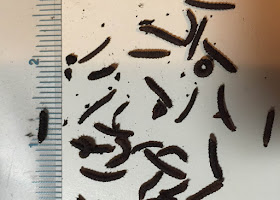By Beth Sullivan
We had an incredibly
mild stretch of weather these last weeks. Several days were warm
enough to allow small gnats and flies to swarm and even a few
butterflies to roam during the day’s sunny warmth. Out in the woods
and thickets, a few lingering warblers and flycatchers got lucky
enough to find sustenance later than usual.
 |
| Invasive Winter Moth |
There is a down side.
Several nights of warmth created perfect conditions for the emergence
of the Winter Moth. This invasive, non-native, insect has been
around for a while, but seemed to burst into our awareness last
spring when leaves on numerous species of trees emerged deformed,
eaten before unfurling. Ornamental and fruiting trees had their
blossoms devoured before opening. Without the blossoms there was no
pollinating and no fruits this past fall. Crab Apples, some
Cherries, and Dogwoods never carried full loads of berries, and this
Autumn the birds lost out.
 |
| Caterpillars go dormant in the soil in masses, then pupate to emerge at this time of year. |
 |
| When leaves emerge in Spring, they are already damaged by the larval Winter Moth. |
Swarming Winter Moths
The life cycle of these
moths is only now being understood. Right now the moths are flying
in clouds and those are only the males! They are small, boring and
light brown. They usually land with wings spread, but they may be
held together, which is unusual for moths. The females have small
non-functioning wings, and when they emerge from the soil, they climb
up the base of the trees where they are found by the males and mate.
They then crawl up the tree to lay their egg masses in cracks and
crevices in the bark, close to leaf buds. The moths die and the eggs
overwinter. The caterpillars emerge very early and begin eating the
leaves and flowers while in bud. They are not terribly fussy, and
they will feed on many tree species, from mighty Oaks to Blueberries
and garden plants. The affected Oaks have produced very few acorns
locally, in an otherwise huge acorn year.
 |
| Gypsy Moth egg masses are easy to spot now and can be scraped off bark. |
When the caterpillars
are done feeding, they drop to the ground where they remain dormant
through the summer, to pupate in the fall. I discovered masses of
these dormant larvae just under the leaf litter as I did fall clean
up in my gardens. They emerge, to continue their cycle, after a
hard frost period and rewarming in mid November and December.
 |
| Male moths, like these brown Gypsy moths, must fly to find the more inactive females waiting on tree trunks. |
The trees that had
significant leaf damage were stressed for the entire season. Some
were able to send out a second set of leaves later, but that is an
enormous expenditure of energy. Then we had the later summer drought
and heat which literally dried out the tender leaves well before they
were due to fall.
 |
| Moths are attracted to lights and swarm on warmer evenings. |
Check your trees
Until entomologists and
landscape contractors can better understand the full life cycle,
there may be no way to interrupt the onslaught. If you can check the
bases of your trees now, it may be possible to find and destroy the
females before they ascend the trunk. Smaller trees in the home
landscape can be treated with a horticultural oil or insecticidal
soap to kill the eggs or larvae early on. I go out and squash them
by the hundreds, even thousands, when they collect by lights I leave
on purposely to attract them. But that is a drop in the bucket. We
cannot protect the entire forest. For now we hope that some natural
predator or disease will be found that will stop their march.
 |
| Several years of defoliation and drought will kill many woodland trees. |
Several years of
stress from infestation and drought, may cause trees to die and we
might expect to see large areas affected like after the Gypsy Moth
invasion of decades ago. A disease evolved to help kill off Gypsy
Moth caterpillars. Their egg masses are easier to find on tree trunks
and can be scraped off. But those moths also reappeared last year in
greater than expected numbers.
Seems to be another
round of bad news for our already stressed woodland habitats.
Photographs by Beth Sullivan

No comments:
Post a Comment